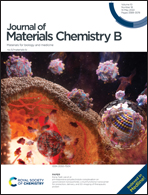A tumour microenvironment-mediated Bi2−xMnxO3 hollow nanospheres via glutathione depletion for photothermal enhanced chemodynamic collaborative therapy†
Abstract
Photothermal-enhanced chemodynamic therapy (CDT) has been attracting increasing attention for effective tumour treatment. Nevertheless, even though Mn-based nanostructures are promising CDT agents, their photothermal conversion capacities are not good enough for an ideal combination therapy. In this work, a bifunctional Bi2−xMnxO3 nanoplatform was developed, with tumour microenvironment (TME)-triggered photothermal therapy (PTT)-enhanced CDT, for a collaborative therapy for tumours. The doping of a small amount of Bi tuned the photothermal and CDT performance of Bi2−xMnxO3, thus promoting the photothermal conversion ability as well as accelerating the ˙OH generation. The existence of reductive Mn4+ could disrupt the internal tumour redox balance by enhancing glutathione (GSH) consumption to improve the CDT effect. Meanwhile, the mild photothermal effect could accelerate the depletion of GSH and the generation of ˙OH in the tumour region after laser irradiation, thus promoting the CDT effect. This manganese-based nanoplatform provides a good strategy for tumour therapy via TME-mediated PTT-enhanced CDT.



 Please wait while we load your content...
Please wait while we load your content...